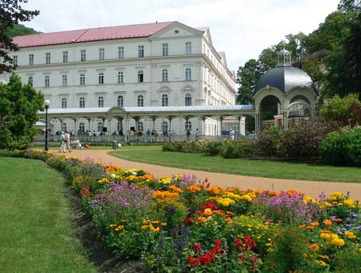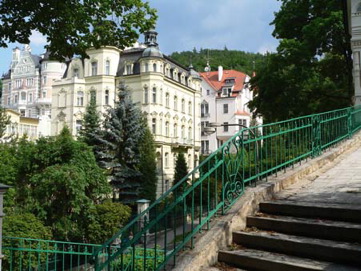Carlsbad
As
the most famous Czech spa, Carlsbad is today, just like in
the past, a favourite destination for both domestic and
foreign tourists. Each year Carlsbad holds its
International Film Festival, which attracts thousands of
Czech and foreign cultural personalities and
representatives from political, economic and diplomatic
spheres.
The origin and development of Carlsbad has always been
inseparably linked to the health-giving properties of its
hot mineral springs, which have made their mark on the
history, architecture, economy and spirit of the city.
According to legend the springs were discovered in the
middle of the 14th century by the Czech king Charles IV
while hunting deer. The establishment of a spa town at the
confluence of the Ohře and Teplá rivers under the
reign of Charles IV was doubtlessly not such an accidental
and romantic affair as the old myth relates, but rather a
logical developmental step for a place that had been known
for so long for its therapeutic traditions.
The precise date on which the town of Carlsbad was
established is not known. A permanent settlement close to
the Thermal Spring has been dated to around 1349, while the
written history of this spa town begins around 1370, when
Charles IV granted the existing settlement its freedoms and
rights.
Until the end of the 17th century Carlsbad retained its
Gothic appearance, with its city gates and the tightly
packed buildings around the Thermal Spring. During the 18th
century the city and its fame blossomed over a period of
several decades. In 1707 emperor Josef I confirmed all
Carlsbad's privileges and named it a royal free city. In
the first half of the 18th century Carlsbad was highly
favoured by the Habsburgs, in particular by empress Maria
Theresia. The town's loyalty to the Viennese court was
positively reflected in financial subsidies for
construction and administration.
The lifetime work of Dr. David Becher, the most worthy of
the city's physicians, was of fundamental importance for
the modernisation of Carlsbad balneology. He introduced a
series of new therapeutic methods and also contributed to
the city's development.
Carlsbad is a city of colonnades, with the most well known
being the Thermal Colonnade, which has altered its
architectonic appearance several times over the years. The
Mill, Market and Orchard Colonnades are also
famous.
 ____
____




